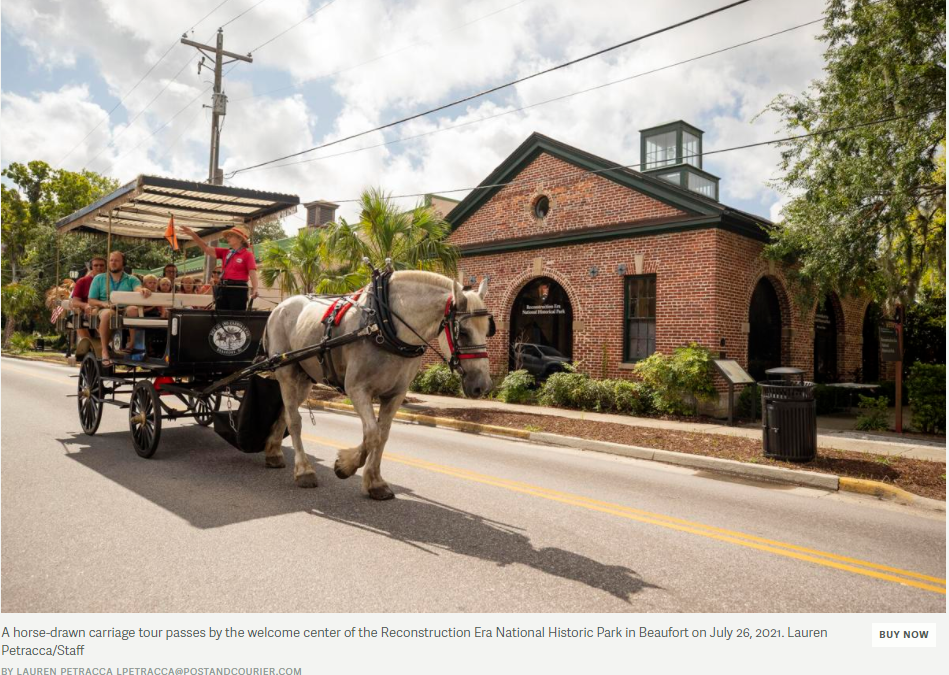SOUTH CAROLINA: Reconstruction Era Subject of New National Park in Beaufort Area
BEAUFORT — In November 1861, early in the Civil War, Union troops assumed control of Port Royal Sound and its adjacent islands. This was meant to be a refueling station for U.S. ships blockading the coast. But it quickly became something else.
As soon as Union forces took over the city, almost all of the Whites abandoned their plantations, churches, homes and shops. Around 10,000 Black people considered the sudden change of circumstances and wondered: “Are we free?” They quickly took the reins of this allegorical empty carriage that had careened off the road. Then they built a new road, paved with equity, on which to ride.
It all happened quickly, raising big questions about how to structure a new society and provide Black people with a path to economic and political power.
This story now is being told by the National Park Service. The new, noncontiguous national park consists of three sites — the Old Beaufort Firehouse downtown, which serves as the visitor center; Darrah Hall at the Penn Center on St. Helena Island; and Camp Saxton, once a recruitment depot and training ground for Black soldiers located in Port Royal. Additional sites could be added in the future.
The park is really telling the story of the whole Port Royal Sound region and its unofficial territory that includes Beaufort’s entire historic district and all of Penn Center, where tours are available to visitors.
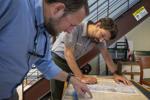
Beaufort Mayor Stephen Murray (left) and National Park Service park ranger Christopher Barr examine property records in the Old Beaufort Fire House, now the welcome center of the Reconstruction Era National Historic Park, on July 26, 2021. Lauren Petracca/Staff
The story is unique. Here enslaved people gained early freedom nearly a year before President Abraham Lincoln’s Emancipation Proclamation, and four years before the end of the war.
What they did was bold and risky, for the outcome of the war and the fate of the institution of slavery were far from certain, noted park ranger Christopher Barr, who is in charge of historical interpretation at Reconstruction Era National Historical Park.
With support from the federal government, they shifted from a slave-labor economic system to a wage-labor system. They pushed hard to provide education to all. They secured property and political power. And they devised a new way to govern, one that promoted political enfranchisement, not retribution and punishment.
The Port Royal Experiment provided the framework and mechanisms that would usher in the Reconstruction period once the war concluded.
“Beaufort was the model,” Barr said.
A new national park
The park is a result of 20 years of effort and advocacy. In 2000, then-Secretary of the Interior Bruce Babbitt and historian Eric Foner visited Beaufort to consider establishing a federal monument to Reconstruction. The idea had been kicked around a while and this meeting was the start of a formal push.
In 2015, commemorations of the 150th anniversary of the Civil War wound down and the National Park Service sought to interpret the history of what immediately followed the war.
Foner and other scholars and advocates continued to recommend Beaufort as the place where the story should be told. In May 2016, South Carolina U.S. Reps. James Clyburn and Mark Sanford introduced a bill in the House “to establish Penn School — Reconstruction Era National Monument in the State of South Carolina as a unit of the National Park System.” It failed.

Gardenia Simmons-White, a 1952 graduate of the Penn School, and now a volunteer at the historic site, walks into the Penn Center’s York W. Bailey Museum on St. Helena Island on July 26, 2021. Lauren Petracca/Staff
Clyburn called Billy Keyserling, Beaufort’s mayor at the time, and said the only way to get this project approved was to garner grassroots support. In December that year, NPS Director Jonathan Jarvis, Clyburn, Keyserling, various delegates from Washington, D.C., and local leaders met for a public hearing at Brick Church on St. Helena Island. The overwhelming sentiment was that the Reconstruction story needed to be told in a comprehensive way, Keyserling said.
No one argued that it would be “good for tourism” or “good for economic development,” he said. The consensus was that it was well past time to assert the importance of this part of American history.
In January 2017, President Barack Obama designated three new national monuments: the Birmingham Civil Rights National Monument, the Freedom Riders National Monument and Reconstruction Era National Monument in Beaufort.
In March 2019, the monument became a park when President Donald Trump signed a Senate bill into law. That bill also converted Fort Sumter and Fort Moultrie from a monument to a park, and it established the Reconstruction Era National Historic Network, enabling administrators to designate various additional sites as part of the Reconstruction story the Beaufort-based park would tell.
Hope and risk
For the National Park Service to operate in a community, it needs property. So a local family donated the Old Beaufort Fire House, and the Penn Center donated Darrah Hall and an easement for Brick Baptist Church. The Camp Saxton site already was part of the Naval Hospital, owned by the federal government. Any properties that might be acquired in the future likely will be deeded to the National Trust for Historic Preservation or National Park Service.
The Fire House is a short walk from dozens of structures of historical importance in the downtown area, many purchased by the formerly enslaved during the tax auction of 1863. At least 31 properties were sold to Black people serving with the 1st Carolina Volunteers during that auction, Barr said. Others also managed to secure abandoned homes and businesses.
Robert Smalls bought the home of his former master, Henry McKee, on Prince Street. His daughter moved into a house around the corner on New Street. Prince Rivers, a formerly enslaved carriage driver, also acquired a house on New Street.
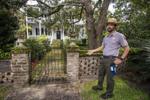
Christopher Barr, a park ranger with the National Park Service, shows the Robert Smalls house in Beaufort on July 26, 2021. Lauren Petracca/Staff
Rivers had stolen a horse from his master, Henry Middleton Stuart Sr., and escaped from slavery in 1862, riding through Confederate lines to Beaufort to join the 1st South Carolina Volunteers, the first Black regiment of the U.S. Army. Rivers’ remarkable story deserves to be better known, something the new park can help accomplish, Barr said.
Smalls, who escaped slavery by commandeering the Confederate transport ship Planter in Charleston Harbor, and Rivers went on to become legislators after the war. Rivers was co-founder of Aiken County. Smalls was a delegate to the 1868 South Carolina state convention, which drafted a new constitution. An advocate for free mandatory public education, he ensured the constitution included a provision guaranteeing it to all.
During Beaufort’s 1862 occupation, Black people were recruited by the thousands to join Union forces. They did so at terrific risk, Barr noted.
They also set up schoolhouses to teach the formerly enslaved of all ages how to read and write. The following year, Gen. Rufus Saxton, military governor of South Carolina, decided to teach financial literacy and authorized the Army to set up a savings bank. On Feb. 3, 1965, Congress, taking its cue from Saxton, established the Freedman’s Bureau and Freedman’s Bank.
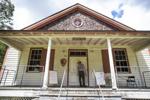
Christopher Barr, a park ranger with the National Park Service, unlocks the door of Darrah Hall at the Penn Center on St. Helena Island on July 26, 2021. The building is part of the Reconstruction Era National Historic Park. Lauren Petracca/Staff
In 1862, a group of escaped slaves, with help from Union Gen. Ormsby Mitchel, founded the first self-governed freedmen’s town in the United States. Mitchelville, on the northeast side of Hilton Head Island, included a street grid, wooden homes, a church and more. Its citizens held elections, passed laws, collected taxes and started businesses and schools. The whole island eventually became predominantly Black through tax auctions, and several additional communities were established there.
Meanwhile, Black soldiers were returning injured from the battlefields. Hospitals cropped up across the Beaufort. Hospital No. 6, a converted mansion overlooking the Beaufort River, received soldiers from the 54th Massachusetts Infantry Regiment, who had fought on Morris Island near Charleston.
One of Frederick Douglass’ sons also was treated here, and Harriet Tubman was a nurse attending to the injured men. Tubman likely rotated among three or four local hospitals for a time, Barr said.
South of the city, in Port Royal, about 5,000 people gathered on Jan. 1, 1863, among the live oaks to listen as Lincoln’s Emancipation Proclamation was read aloud. The men of the 1st South Carolina Volunteers, who had completed their training at Camp Saxton, received their regimental colors that morning. Then the crowd sang “My Country ’Tis of Thee.”
“Just think of it!” wrote Col. Thomas Higginson, describing the scene. “The first day they had ever had a country, the first flag they had ever seen which promised anything to their people … the life of the whole day was in those unknown people’s song.”
Promise and disappointment
“Locally, we’ve done a nice job protecting these sites and keeping history alive, but now it’s time to expand that history and share it with others,” Beaufort Mayor Stephen Murray said in an interview. It’s especially important to do so given recent political efforts to arrest civil rights progress and turn back the clock, he added. “Reconstruction, and Jim Crow that follows, is a significant lesson for us.”
During the occupation of Beaufort, the formerly enslaved took control of abandoned churches to worship freely and strengthen the fabric of their community.
These churches doubled as schools, four of which were downtown. One, Brick Baptist Church on St. Helena Island, became a central component of the nascent Penn School.
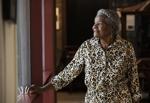
Gardenia Simmons-White, a 1952 Penn School graduate, is pictured in the York W. Bailey Museum at the Penn Center on St. Helena Island on July 26, 2021. She works at the historic site as a volunteer. Lauren Petracca/Staff
Gardenia Simmons-White graduated from the Penn School in 1952 and now volunteers in the welcome center. She said the site has been booming lately: Visitors want to learn about the history of this place.
That history begins in 1862, when two Quaker missionaries, Laura Towne and Ellen Murray, came from Philadelphia to help. They set up a school in a plantation house, but soon moved to the Brick Church, a structure slaves had built in 1855 for use by a White congregation. Fingerprints of brickmakers, some no doubt very young, can be spotted easily.
The one-room church filled with perhaps 100 students of all ages, eager to learn. Towne and Murray soon were joined by Charlotte Forten, a well-off African American, also from Philadelphia, who came to help teach an expanding student population.

Christopher Barr, a park ranger with the National Park Service, points out on July 26, 2021, fingerprints left in bricks made by enslaved people for the construction of Brick Baptist Church, part of the Penn Center on St. Helena Island. Lauren Petracca/Staff
The church was better than the plantation house, but inadequate to the task. St. Helena Island was a remote bastion of Gullah culture which few White people dared to visit, even after the end of Reconstruction. Thousands sought to improve their circumstances.
Fortunately, Hastings Gantt, a former slave who gained possession of property near the church, sold 50 acres to the missionaries. The Penn School found a permanent home just across the street from the church.
Barr said he likes to contemplate the child whose fingerprints were imprinted in the bricks of the building back in 1855, and who perhaps became a scholar attending sessions in that same structure in 1862, then benefited from a new state constitution in 1868 which made him a full-fledged citizen. Less than two years later, in 1870, that citizen would gain the right to vote, thanks to the 15th Amendment. Could he have imagined as a child what would happen in the course of just 15 years?
But then it all began to unravel. By the 1870s, white supremacist groups such as the Ku Klux Klan used terror and intimidation to prevent Black people from exercising their newfound right to vote. Violence and fraud were employed to remove Black leaders from office.
The presidential election of 1876, which pitted Republican Rutherford B. Hayes against Democrat Samuel J. Tilden, concluded with a devil’s bargain: Hayes would secure support from Southern Democrats in exchange for Southern autonomy. That meant the withdrawal of federal troops tasked with preventing the disenfranchisement of African Americans.
Beginning in 1890, state legislatures, now predominantly White, drafted new constitutions codifying racial discrimination. The Jim Crow era was underway.
–postandcourier.com

